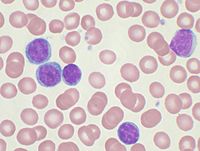
Photo from wikipedia
Background The genetic regulation of apoptosis and cell proliferation plays a role in the growth of chronic lymphocytic leukemia (CLL), the most common form of leukemia in the Western hemisphere.… Click to show full abstract
Background The genetic regulation of apoptosis and cell proliferation plays a role in the growth of chronic lymphocytic leukemia (CLL), the most common form of leukemia in the Western hemisphere. Although thyroid hormone receptor interactors (TRIPs) are known to play roles in cell cycle, the potential involvement of the novel family member TRIP13 in CLL has not yet been investigated. Methods Quantitative PCR (qPCR) was used to detect expression of TRIP13 in 36 CLL patients and 33 healthy donors CD19+ B cells. Loss-of-function (siRNA) assays were used to alter TRIP13 expression levels. The effect of TRIP13 on cell proliferation and apoptosis was measured by MTT, Annexin V-based flow cytometry and Caspase 3/7 activity assay. Affymetrix GeneChip and Ingenuity Pathway Analysis (IPA) were used to describe an overview of TRIP13 potential biological function and downstream pathways. Dual-luciferase reporter assay was performed to assess the promoting effect of c-MYC on TRIP13 transcription. RESULTS The qPCR data showed that TRIP13 is significantly over-expressed in CLL patients. Microarray analyses indicated that the biological function of TRIP13 in CLL is majorly cell apoptosis and cell proliferation associated. TRIP13 siRNA expressing cells exhibited a slower cell proliferation rate and underwent apoptosis compared with control cells. TRIP13 knockdown induced CLL cells apoptosis through PUMA independent of p53. TRIP13 up-regulation is induced by c-MYC dependent transcriptional activation. Conclusion Overall, our data suggest the bio-function of TRIP13 in CLL cell for the first time, and that this gene might be a therapeutic target for CLL.
Journal Title: Oncotarget
Year Published: 2017
Link to full text (if available)
Share on Social Media: Sign Up to like & get
recommendations!